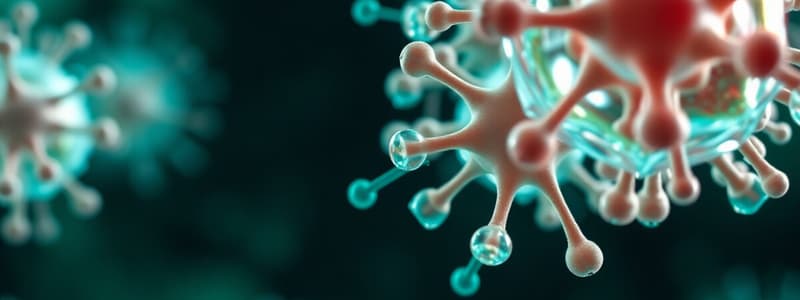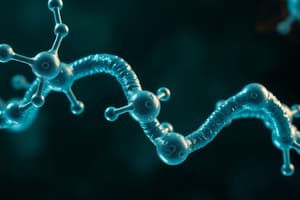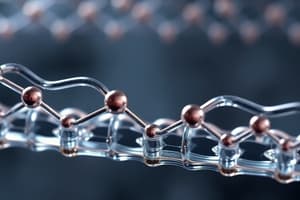Podcast
Questions and Answers
What type of bond forms between the 5'-phosphate of one nucleotide and the 3'-OH of another nucleotide?
What type of bond forms between the 5'-phosphate of one nucleotide and the 3'-OH of another nucleotide?
- Hydrogen bond
- Phosphodiester bond (correct)
- Ionic bond
- Covalent bond
Which of the following is NOT a function of RNA?
Which of the following is NOT a function of RNA?
- Stores genetic information (correct)
- Modulates gene expression
- Involved in protein synthesis
- Carries information from DNA
Which nitrogenous base is found in RNA but not in DNA?
Which nitrogenous base is found in RNA but not in DNA?
- Thymine
- Adenine
- Uracil (correct)
- Cytosine
In what direction are polynucleotides synthesized?
In what direction are polynucleotides synthesized?
What structural feature distinguishes DNA from RNA?
What structural feature distinguishes DNA from RNA?
What is the role of cholesterol-derived hormones like testosterone and estradiol?
What is the role of cholesterol-derived hormones like testosterone and estradiol?
Which component contributes to the amphipathic nature of cholesterol?
Which component contributes to the amphipathic nature of cholesterol?
What is the primary information molecule in cells?
What is the primary information molecule in cells?
What is the main function of polysaccharides mentioned?
What is the main function of polysaccharides mentioned?
Which formula represents monosaccharides?
Which formula represents monosaccharides?
Which statement is true about cyclized sugars?
Which statement is true about cyclized sugars?
What type of bond joins monosaccharides together?
What type of bond joins monosaccharides together?
How does cellulose differ from starch?
How does cellulose differ from starch?
Which of the following polysaccharides is formed mainly of glucose?
Which of the following polysaccharides is formed mainly of glucose?
What type of bonds primarily link glucose molecules in glycogen and starch?
What type of bonds primarily link glucose molecules in glycogen and starch?
What role do carbohydrates play in cell signaling?
What role do carbohydrates play in cell signaling?
What percentage of the human body weight is made up by oxygen, hydrogen, carbon, and nitrogen?
What percentage of the human body weight is made up by oxygen, hydrogen, carbon, and nitrogen?
Which of the following is true about water in cells?
Which of the following is true about water in cells?
What is the primary function of carbohydrates in cells?
What is the primary function of carbohydrates in cells?
Which of the following statements about inorganic ions in cells is correct?
Which of the following statements about inorganic ions in cells is correct?
Which organic molecule type makes up over 90% of the dry weight of most cells?
Which organic molecule type makes up over 90% of the dry weight of most cells?
How do nonpolar molecules behave in an aqueous medium?
How do nonpolar molecules behave in an aqueous medium?
Which of the following ions is categorized as a monovalent cation?
Which of the following ions is categorized as a monovalent cation?
What role do polysaccharides play in cells?
What role do polysaccharides play in cells?
What is the primary role of phospholipids in cells?
What is the primary role of phospholipids in cells?
What characterizes the structure of fatty acids?
What characterizes the structure of fatty acids?
How are triglycerides formed?
How are triglycerides formed?
Why are triglycerides more efficient energy storage than carbohydrates?
Why are triglycerides more efficient energy storage than carbohydrates?
What is a key feature of phospholipids that allows them to form membranes?
What is a key feature of phospholipids that allows them to form membranes?
What type of molecule is sphingomyelin?
What type of molecule is sphingomyelin?
What is the primary role of lipid signaling molecules such as steroid hormones?
What is the primary role of lipid signaling molecules such as steroid hormones?
What do glycolipids contribute to cell membranes?
What do glycolipids contribute to cell membranes?
What is the primary function of ATP within cells?
What is the primary function of ATP within cells?
What distinguishes polar amino acids from nonpolar amino acids?
What distinguishes polar amino acids from nonpolar amino acids?
Which statement about the peptide bonds between amino acids is accurate?
Which statement about the peptide bonds between amino acids is accurate?
What is the significance of the N-terminal and C-terminal ends of a polypeptide?
What is the significance of the N-terminal and C-terminal ends of a polypeptide?
Why are proteins considered the most varied macromolecules?
Why are proteins considered the most varied macromolecules?
What role do proteins play in the immune response?
What role do proteins play in the immune response?
How did Frederick Sanger contribute to the understanding of proteins in 1953?
How did Frederick Sanger contribute to the understanding of proteins in 1953?
What aspect of proteins is primarily responsible for their function?
What aspect of proteins is primarily responsible for their function?
What defines the primary structure of proteins?
What defines the primary structure of proteins?
Which of the following describes the secondary structure of proteins?
Which of the following describes the secondary structure of proteins?
What crucial role do hydrogen bonds play in protein structures?
What crucial role do hydrogen bonds play in protein structures?
How do phospholipids contribute to the structure of cell membranes?
How do phospholipids contribute to the structure of cell membranes?
What is the effect of temperature on the fluidity of lipid bilayers?
What is the effect of temperature on the fluidity of lipid bilayers?
Which structure is responsible for defining the internal compartments of eukaryotic cells?
Which structure is responsible for defining the internal compartments of eukaryotic cells?
What is one of the primary functions of membrane proteins?
What is one of the primary functions of membrane proteins?
Which characteristic of lipid bilayers is crucial for their function?
Which characteristic of lipid bilayers is crucial for their function?
Flashcards
What are cells?
What are cells?
The primary building blocks of cells, capable of replicating and performing specialized tasks in multicellular organisms.
What are the three fundamental elements of cells?
What are the three fundamental elements of cells?
Water, inorganic ions, and organic molecules (containing carbon).
Describe the properties of water.
Describe the properties of water.
A molecule with a slightly positive charge on the hydrogen atoms and a slightly negative charge on the oxygen atom, allowing it to form hydrogen bonds.
What is the significance of inorganic ions in cells?
What is the significance of inorganic ions in cells?
Signup and view all the flashcards
What are organic molecules?
What are organic molecules?
Signup and view all the flashcards
What is the role of carbohydrates in cells?
What is the role of carbohydrates in cells?
Signup and view all the flashcards
What are polysaccharides and their functions?
What are polysaccharides and their functions?
Signup and view all the flashcards
What are proteins?
What are proteins?
Signup and view all the flashcards
Monosaccharide
Monosaccharide
Signup and view all the flashcards
Cyclized Sugar
Cyclized Sugar
Signup and view all the flashcards
Glycosidic Bond
Glycosidic Bond
Signup and view all the flashcards
Oligosaccharide
Oligosaccharide
Signup and view all the flashcards
Polysaccharide
Polysaccharide
Signup and view all the flashcards
Glycogen
Glycogen
Signup and view all the flashcards
Starch
Starch
Signup and view all the flashcards
Cellulose
Cellulose
Signup and view all the flashcards
What are fatty acids?
What are fatty acids?
Signup and view all the flashcards
What are triglycerides?
What are triglycerides?
Signup and view all the flashcards
What are phospholipids?
What are phospholipids?
Signup and view all the flashcards
What are phosphoglycerides?
What are phosphoglycerides?
Signup and view all the flashcards
What is sphingomyelin?
What is sphingomyelin?
Signup and view all the flashcards
What is cholesterol?
What is cholesterol?
Signup and view all the flashcards
What are glycolipids?
What are glycolipids?
Signup and view all the flashcards
What is the overall importance of lipids in cells?
What is the overall importance of lipids in cells?
Signup and view all the flashcards
What are nucleic acids?
What are nucleic acids?
Signup and view all the flashcards
What is DNA?
What is DNA?
Signup and view all the flashcards
What is mRNA?
What is mRNA?
Signup and view all the flashcards
How are nucleic acids formed?
How are nucleic acids formed?
Signup and view all the flashcards
What is the direction of nucleic acid synthesis?
What is the direction of nucleic acid synthesis?
Signup and view all the flashcards
What is the role of the base sequence in nucleic acids?
What is the role of the base sequence in nucleic acids?
Signup and view all the flashcards
What is ATP?
What is ATP?
Signup and view all the flashcards
What is cAMP's role in cells?
What is cAMP's role in cells?
Signup and view all the flashcards
What are the main functions of proteins?
What are the main functions of proteins?
Signup and view all the flashcards
What are the components of an amino acid?
What are the components of an amino acid?
Signup and view all the flashcards
How does the side chain (R group) affect an amino acid?
How does the side chain (R group) affect an amino acid?
Signup and view all the flashcards
What is a peptide bond?
What is a peptide bond?
Signup and view all the flashcards
What is a polypeptide chain?
What is a polypeptide chain?
Signup and view all the flashcards
Why is protein folding important?
Why is protein folding important?
Signup and view all the flashcards
Primary Structure of Protein
Primary Structure of Protein
Signup and view all the flashcards
Secondary Structure of Protein
Secondary Structure of Protein
Signup and view all the flashcards
Tertiary Structure of Protein
Tertiary Structure of Protein
Signup and view all the flashcards
Quaternary Structure of Protein
Quaternary Structure of Protein
Signup and view all the flashcards
Phospholipid Bilayer
Phospholipid Bilayer
Signup and view all the flashcards
Membrane Proteins
Membrane Proteins
Signup and view all the flashcards
Membrane Fluidity
Membrane Fluidity
Signup and view all the flashcards
Selective Permeability
Selective Permeability
Signup and view all the flashcards
Study Notes
Unit 2: Molecules and Membranes
- This unit introduces the fundamental molecules and membranes within cells.
Section 1: Introduction
- Molecules and membranes are key components of cells.
Index
- 2.1 Cell Molecules:
- Carbohydrates (sugars)
- Lipids (fats)
- Nucleic acids (DNA, RNA)
- Proteins
- 2.2 Cell Membranes:
- Membrane lipids (phospholipids, glycolipids, cholesterol)
- Membrane proteins (integral and peripheral)
- Transport across cell membranes (passive and active)
2.1 Cell Molecules
- Cells are complex structures with specialized functions.
- Cells are composed of water, inorganic ions, and organic molecules (containing carbon).
Water
- Water accounts for a significant percentage (70% or more) of cell mass.
- Water is a polar molecule with slightly positive hydrogen atoms and a slightly negative oxygen atom.
- This polarity allows water to form hydrogen bonds with other polar molecules and charged ions.
- Water molecules interact with polar molecules (hydrophilic), while nonpolar molecules (hydrophobic) do not interact well with water.
Inorganic Ions
- Inorganic ions represent a smaller percentage (1% or less) of cell mass.
- These ions play critical roles in cellular functions and metabolism.
- Examples include sodium (Na+), potassium (K+), magnesium (Mg2+), calcium (Ca2+), chloride (Cl-), hydrogen phosphate (HPO42-), and bicarbonate (HCO3-).
Organic Molecules
- Organic molecules make up over 90% of the dry weight of most cells.
- The molecules are diverse, including carbohydrates, lipids, proteins, and nucleic acids.
- Macromolecules are formed by polymerizing smaller precursors (monomers).
Carbohydrates
- Simple sugars (monosaccharides): Main cellular nutrients with energy functions.
- Polysaccharides: These are structural components and energy storage forms.
- Examples include glycogen (animal cells) and starch (plant cells).
- Cellulose provides structural support in plant cell walls.
Monosaccharides
- The basic formula is (CH2O)n, where n is the number of carbons.
- Glucose is a primary source of energy in cells.
- Other monosaccharides have between 3-7 carbons.
- Sugars with 5 or more carbons often form ring structures in cells.
- Glucose exists in two forms, α and β, depending on the placement of the hydroxyl group on C1.
Glycosidic Bonds
- Monosaccharides link together through dehydration reactions to form polysaccharides.
- The resulting bonds are glycosidic bonds.
- If only a few sugars are attached, the resulting polymer is called an oligosaccharide
- Polymers of hundreds or thousands of sugars are called polysaccharides.
Glycogen and Starch
- Glycogen is the storage form of carbohydrates in animals.
- Starch stores carbohydrates in plants
- Both glycogen and starch are composed of glucose molecules.
- Glycogen is more highly branched than starch.
Cellulose
- Cellulose is a structural component of plant cells (cell walls).
- It consists of glucose molecules linked by β (1→4) glycosidic bonds.
- Straight chains of cellulose molecules are packed together to form strong fibers that provide structural integrity.
Lipids
- Lipids are mainly composed of hydrocarbon chains with a carboxyl group.
- Fatty acids (the simplest lipids) contain long hydrocarbon chains and a carboxyl group.
- Triglycerides are energy storage molecules formed from glycerol and fatty acids.
- Cell membranes are composed primarily of phospholipids (composed of fatty acids, glycerol, and a phosphate group).
Phospholipids
- Phospholipids are amphipathic molecules: both hydrophobic and hydrophilic, forming cell membranes.
- Hydrophobic tails of the phospholipids orient inward, and the hydrophilic heads face outward.
- Phospholipids form a bilayer, with the hydrophobic tails facing each other and the hydrophilic heads contacting the aqueous environment.
- The phospholipid bilayer is responsible for compartmentalization within cells.
Cholesterol
- Cholesterol is a component of animal cell membranes.
- It has a steroid structure differing from phospholipids in that it contains a fused ring structure.
- Cholesterol affects the fluidity of the membrane, preventing excessive rigidity at low temperatures and excessive fluidity at high temperatures
Nucleic Acids
- Nucleic acids are the primary information carriers of cells.
- DNA (deoxyribonucleic acid) is the blueprint of genetic material in most organisms.
- RNA (ribonucleic acid) is involved in protein synthesis.
- RNA comes in different types (mRNA, rRNA, tRNA), each with specific functions.
Nucleotides
- Nucleotides are the building blocks of nucleic acids.
- Nucleotides consist of a nitrogenous base, a sugar (deoxyribose or ribose), and a phosphate group.
- Purines (adenine and guanine) and pyrimidines (cytosine, thymine, and uracil) are examples of nitrogenous bases
Proteins
- Proteins are a diverse group of macromolecules performing essential tasks in the cell.
- Proteins are polymers of amino acids connected by peptide bonds.
- Amino acids have 20 different types; their properties (polar, nonpolar, acidic, basic) affect protein structure and function.
Protein Structure
- Primary: The amino acid sequence of a polypeptide chain.
- Secondary: Hydrogen bond formation between amino acid backbones (alpha helix, beta sheet).
- Tertiary: The three-dimensional folding of the polypeptide.
- Quaternary: Multiple polypeptide chains interacting to form a functional protein complex.
Cell Membranes
- Cell membranes separate the inside of the cell from its surroundings.
- All cell membranes are composed of a phospholipid bilayer and proteins embedded within it.
- The phospholipid bilayer regulates the passage of substances across the membrane.
Membrane Proteins
- Integral proteins are embedded in the lipid bilayer, often spanning the entire width of the membrane forming channels or carriers that help move substances across the membrane.
- Peripheral proteins are associated with the membrane surface (inside or outside)
Transport Across Membranes
- Passive transport involves the movement of molecules from an area of high concentration to an area of low concentration (along a concentration gradient).
- Active transport involves the movement of molecules against a concentration gradient using energy (ATP).
- Membrane proteins (channels and carriers) assist in transport across membranes.
Studying That Suits You
Use AI to generate personalized quizzes and flashcards to suit your learning preferences.



